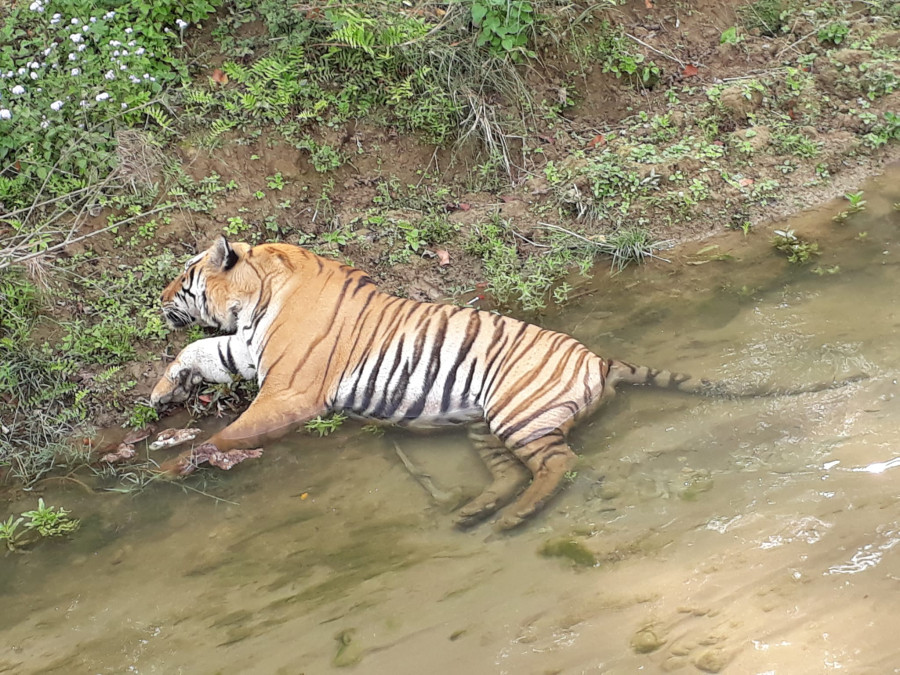Lumbini Province
Soaring costs in tiger rehabilitation worry conservation authorities
It is costly to keep rescued and controlled tigers fed and provide them treatment, care, say Bardiya park officials.
Kamal Panthi
The high upkeep cost of controlled tigers in Bardiya National Park has conservation authorities worried about the long-term impact the burgeoning cost will have on their conservation efforts.
It is expensive to keep rescued and controlled tigers fed and provide treatment and care during their lifetime, say park officials.
According to Bardiya National Park, a major habitat of Royal Bengal tigers in Nepal, a controlled tiger needs around six kilograms of buffalo meat every day. Tigers in the national park prey on various deer species, blue bulls and other animals when they are in the forest but rescued and controlled tigers are kept in a concrete enclosure until they start exhibiting behavioural changes indicating they are ready for assimilation into the forests.
The park administration generally takes tigers that trouble people into control and those that are injured or ailing. Tigers from the Bardiya National Park have killed as many as 22 people in the past three years. The park administration controlled five tigers in the same time period. One of them broke the cage and entered the Banke National Park forests while another was sent to the central zoo in Lalitpur. Three tigers are currently kept in closed enclosures in the Rammapur and Thakurdwar areas of the national park.
“The annual expenditure to keep a tiger in a closed enclosure is more than Rs 6 million,” said Bishnu Prasad Shrestha, the chief conservation officer at the Bardiya National Park. “An additional Rs 1 million needs to be spent on caretakers.”
According to him, the national park has mobilised two assistant employees, one veterinary doctor and some wildlife technicians for the care of three tigers that are kept in the closed enclosures.
“Treatment of tigers is also expensive. When they have minor ailments, we mix medicines in their food and give it to them orally,” said Shrestha. “But in some cases, darting them is the only option.”
Controlling tigers that are either injured, diseased or violent is also not easy.
“A lot goes into controlling such a tiger. We first need to identify them and then mobilise elephants, technicians, veterinary doctors and security personnel to bring them under control,” said Rabin Kadariya, Bardiya chief of the National Trust for Nature Conservation.
The Bardiya National Park has three closed enclosures—two in Rammapur and one in Thakurdwar—to keep rescued or controlled tigers. An employee at the park said that the national park could not rescue or control more tigers as all three enclosures are now occupied.
According to the Bardiya National Park administration, it costs approximately Rs 10 million to construct an enclosure for keeping tigers.
Conservationists, however, argue that it is not good to keep tigers, which roam around the forest, in concrete enclosures. With an objective to address the issue, the Bardiya National Park has recently proposed a plan to launch an open zoo safari.
The park administration recently submitted a proposal to the Ministry of Forest and Environment as well as the Department of National Parks and Wildlife Conservation with a plan of keeping tigers, especially those brought under control for their troublesome activities and moved to the national park, in the open zoo safari. In its proposal, the national park says it plans to install iron fencing around 25 hectares of land in the park forests to keep the controlled tigers. The park administration believes this new approach will help conserve the tiger population in the country.
The proposal asks for around Rs40 million budget to set up the open zoo safari, which would be the first of its kind in the country. But the proposal is yet to be approved.




 7.12°C Kathmandu
7.12°C Kathmandu












